IDEXX SDMA
Hyperthyroid cats and the IDEXX SDMA Test
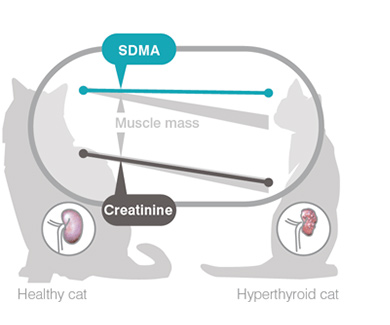
SDMA is not impacted as muscle mass decreases.
Creatinine decreases as muscle mass decreases.
Hyperthyroidism is a disease seen primarily in older cats, in which kidney disease is also common.
The clinical challenge is that hyperthyroidism can mask the presence of kidney disease,1 and until now, there has not been a reliable routine diagnostic test that can assess kidney function in cats affected by hyperthyroidism.2
Creatinine, being a by-product of muscle, is underproduced in feline hyperthyroidism as a result of muscle loss and becomes a poor indicator of kidney function. Creatinine is also lowered by the hyperfiltration associated with the increased metabolic state.
The IDEXX SDMA Test is not impacted by weight loss and muscle mass and appears to be only slightly blunted by hyperfiltration,3 making it a much more reliable marker of kidney function in hyperthyroid cats.4
More reliable
When 1,959 cats were evaluated, creatinine levels dropped whereas the SDMA concentrations remained relatively unchanged. Thus SDMA was able to identify significantly more cats with poor kidney function. When provided, the average body weight had significantly declined in this population of cats.3
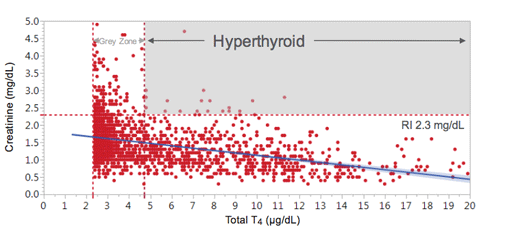
Creatinine decreases with loss of muscle mass in hyperthyroid cats, making it unreliable in detecting underlying kidney disease.
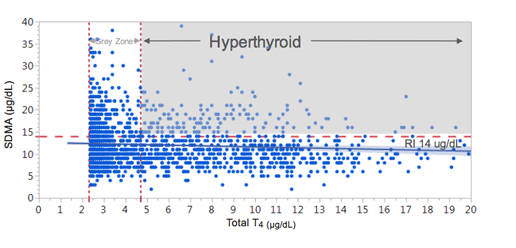
SDMA* is not impacted by loss of muscle mass in hyperthyroid cats, making it a more reliable indicator of underlying kidney disease.
Data research findings
SDMA is a more reliable indicator of kidney function in hyperthyroid cats than creatinine. To demonstrate that SDMA remains relatively stable in the face of both muscle loss and hyperfiltration, a large retrospective data analysis3 was performed comparing creatinine and SDMA results in cats older than 5 years of age. It also compared the number of cats with kidney disease identified by creatinine versus the number of cats identified by SDMA as having kidney disease.
The prevalence of kidney disease was evaluated in a general population of cats and compared to a hyperthyroid feline population.
In the general feline population: Creatinine was found to be increased above the reference interval in only 14% of the cats; SDMA was increased in 27% (figure 1). These results align with numerous studies that have shown that SDMA can detect kidney disease when creatinine is normal because SDMA is specific to kidney function, not impacted by muscle mass, and not impacted by diet or gender, and it is more sensitive at identifying disease earlier.3–7 These findings suggest that by using the IDEXX SDMA Test, veterinarians have the opportunity to diagnose kidney disease 2 times more in feline patients.
In the hyperthyroid feline population: Creatinine results above the reference interval decreased dramatically from 14% to 3.5% in the general population; whereas, the proportion of cats with increased SDMA above the reference interval remained similar to the general population at 20.6% (figure 2).
This robust retrospective data analysis demonstrated that there is a profound effect on creatinine results in hyperthyroid cats. The decrease in creatinine results are due to loss of muscle mass and hyperfiltration, where SDMA results were only slightly blunted as a result of hyperfiltration effects.
Conclusion: The IDEXX SDMA™ Test reliably identified 6 times more hyperthyroid cats with kidney disease than creatinine. Creatinine missed 82%† of hyperthyroid cats that the IDEXX SDMA Test identified as having kidney disease.
Prevalence graphs
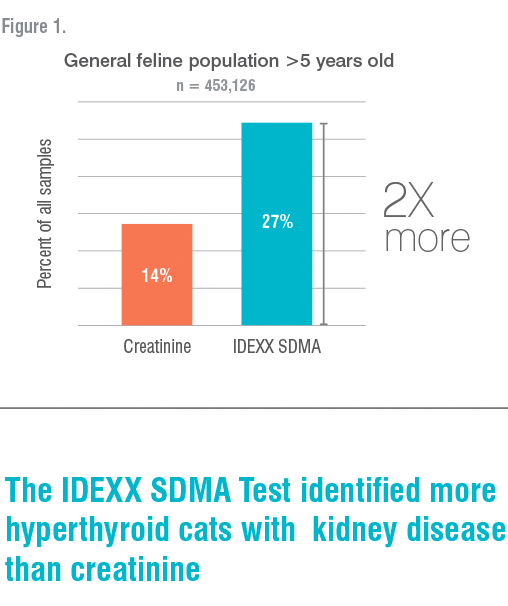
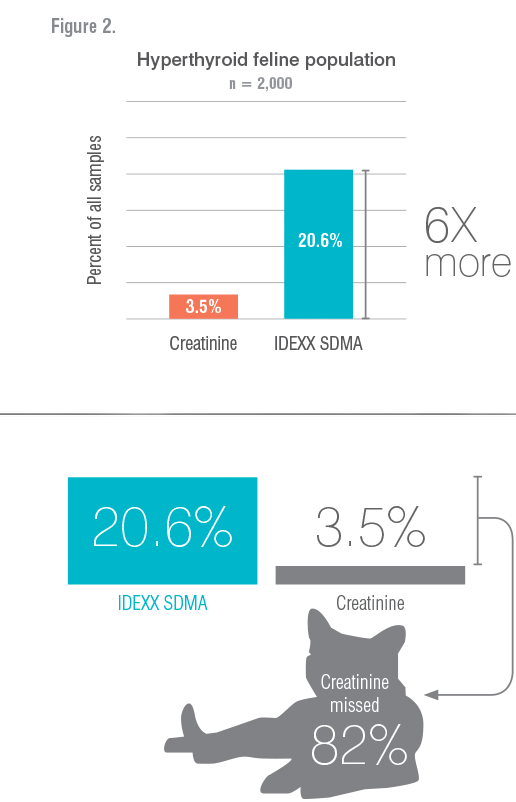
References
- Williams T. Chronic kidney disease in cats with hyperthyroidism. Clin Brief. Sept 2015:10–12.
- Jepson R. Feline hyperthyroidism and chronic kidney disease. In: Proceedings from the BSAVA Congress; April 9–12, 2015; Birmingham, UK.
- Data on file at IDEXX Laboratories, Inc. Westbrook, Maine USA.
- Hall JA, Yerramilli M, Obare E, Yerramilli M, Yu S, Jewell DE. Comparison of serum concentrations of symmetric dimethylarginine and creatinine as kidney function biomarkers in healthy geriatric cats fed reduced protein foods enriched with fish oil, L-carnitine, and medium-chain triglycerides. Vet J. 2014;202(3):588–596.
- Hall JA, Yerramilli M, Obare E, Yerramilli M, Melendez LD, Jewell DE. Relationship between lean body mass and serum renal biomarkers in healthy dogs. J Vet Intern Med. 2015;29(3):808–814.
- Hall JA, Yerramilli M, Obare E, Yerramilli M, Jewell DE. Comparison of serum concentrations of symmetric dimethylarginine and creatinine as kidney function biomarkers in cats with chronic kidney disease. J Vet Intern Med. 2014;28(6):1676–1683.
- Hall JA, Yerramilli M, Obare E, Yerramilli M, Almes K, Jewell DE. Serum concentrations of symmetric dimethylarginine and creatinine in dogs with naturally occurring chronic kidney disease. J Vet Intern Med. 2016;30(3):794–802.</lo>
* Symmetric dimethylarginine.
† Kidney disease was identified in 72 hyperthyroid cats out of the total general feline population (n = 2,000), or 3.5%, using creatinine alone. However, kidney disease was identified in 412 hyperthyroid cats out of the total general feline population, or 20.6%, by adding the IDEXX SDMA Test. This means that using creatinine alone missed 340 hyperthyroid cats with kidney disease, or 82%.